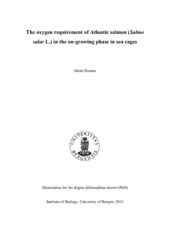| dc.description.abstract | Atlantic salmon aquaculture is a successful and growing industry, with a global production of more than 1.4 million tonnes in 2010. In the on-growing phase, Atlantic salmon are normally kept in sea cages, where both the water temperature and oxygen levels may fluctuate substantially over time and with depth. Oxygen is the main limiting factor of fish metabolism, and sufficient oxygen is therefore essential for all energy-demanding processes, including growth and basic life-supporting functions. Knowledge of the dissolved oxygen (DO) requirement of Atlantic salmon in the on-growing phase, and this species’ ability to cope with observed fluctuations in DO (30-120% O2) is however limited. The overall aim of this thesis was therefore to study the physiology and production performance of Atlantic salmon in response to changes in the oxygen availability, in order to establish knowledge that can be used to assess whether growth and welfare is compromised as a result of insufficient oxygen in the on-growing phase. Insufficient oxygen supply (environmental hypoxia) is primarily considered to be a problem in summer and autumn, and to occur in short/ frequent rather than prolonged periods. The studies of responses to oxygen fluctuations were therefore performed at 16 °C (a typical autumn temperature along the Western coast of Norway) and with hypoxia occurring in cycles corresponding to the turn of the tidal current, resembling previous observations in sea cages (2 h of hypoxia every 6 h, termed “cyclic hypoxia”). However, the oxygen requirement of fish is known to increase with temperature and with the level of activity. For the determination of the minimum DO requirement of Atlantic salmon, temperatures were therefore set to range between 6 and 18 °C, and the experimental conditions were set to induce activity levels as similar to fish in sea cages as possible. For the typical autumn temperature of 16 °C, the threshold for optimal feeding of Atlantic salmon post-smolts was ~70% O2. Feed intake, and presumably also the digestion rate, decreased with increasing hypoxia severity, reaching low levels as DO approached the hypoxia tolerance threshold of 47% O2. Below this DO threshold, fish were no longer able to maintain their oxygen uptake rate, and resorted to anaerobic ATP production to cover their energy demand. Further, a general stress response was induced at DO equivalent to 51-54% O2, and a few fish died during the first day of hypoxic periods (40 and 50% O2). The limited ability to maintain basic functions and the stress and compromised survival at DO below the hypoxia tolerance threshold, demonstrate that this is a limit for acceptable drops in oxygen in Atlantic salmon sea cages, both with regard to production performance and welfare. For postsmolts with low swimming speed and relatively low growth rates, this threshold increased exponentially with temperature, from 29 to 55% O2 at temperatures ranging from 6-18 °C. It was estimated that this threshold should be increased by approximately 40% (i.e. 41-77% O2) in order to serve as practical guideline for salmon farming, due to the higher level of activity (feed intake, swimming speed etc.) that can be expected for fish in sea cages. The reduced feed intake of post-smolts in hypoxic periods was to a large extent compensated for by increased feeding in normoxic periods. This compensation developed after the initial stress response was down-regulated (< 1 week). However, feeding in normoxia did not fully alleviate the negative effects when hypoxia occurred for 2 h every 6 h. As growth reflected feed intake, it was concluded that such frequency and duration of hypoxia reduce the growth and welfare of Atlantic salmon, if DO is reduced below the general threshold of 70% O2 in hypoxic periods, and that the degree of negative effect depends on the hypoxia severity. The relatively large capacity for normoxic compensation does however suggest that negative effects of moderate hypoxia (DO>hypoxia tolerance threshold) may be fully alleviated if the hypoxic periods are of shorter duration and/or frequency. The hypoxia sensitivity of Atlantic salmon was not considerably reduced as a result of acclimation to cyclic hypoxia, as indicated by the persisting anaerobiosis and inhibited feed intake during the hypoxic periods. The main conclusions from this thesis is that reductions in DO below the hypoxia tolerance threshold is unacceptable both with regard to production performance and welfare, while negative effects of DO ranging between this threshold and the threshold for maintained feeding depend on hypoxia severity, frequency and duration. Acclimation to hypoxia did not reduce hypoxia sensitivity, while habituation to hypoxic stress was linked to an increased compensatory feeding in normoxic periods. Hypoxia occurring for ~2 h in tidal cycles (~every 6 h) was not fully compensated for, in spite of stress habituation and normoxic feeding. | en_US |
| dc.relation.haspart | Paper I: Mette Remen, Frode Oppedal, Thomas Torgersen, Albert K. Imsland, Rolf Erik Olsen, Effects of cyclic environmental hypoxia on physiology and feed intake of post-smolt Atlantic salmon: Initial responses and acclimation. Aquaculture 326–329, 148–155. Full-text not available in BORA. The published version is available here: <a href="http://dx.doi.org/10.1016/j.aquaculture.2011.11.036" target="blank">http://dx.doi.org/10.1016/j.aquaculture.2011.11.036</a> | en_US |
| dc.relation.haspart | Paper II: Mette Remen, Turid Synnøve Aas, Tone Vågseth, Thomas Torgersen, Rolf Erik Olsen, Albert K. Imsland, Frode Oppedal, Production performance of Atlantic salmon post-smolts in cyclic hypoxia and following compensatory growth. Accepted for publication in Aquaculture Research 24 September 2012. Resubmitted after minor revision on 16 October 2012. The article is available here: <a href="http://hdl.handle.net/1956/9536" target="blank">http://hdl.handle.net/1956/9536</a> | en_US |
| dc.relation.haspart | Paper III: Mette Remen, Frode Oppedal, Albert K. Imsland, Rolf Erik Olsen, Thomas Torgersen, Hypoxia tolerance thresholds for post-smolt Atlantic salmon: Dependency of temperature and hypoxia acclimation. Manuscript ready for submission to Aquaculture.The article is available here: <a href="http://hdl.handle.net/1956/9539" target="blank">http://hdl.handle.net/1956/9539</a> | en_US |
